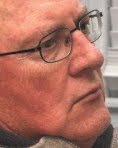

The transfer function for filters constructed from cascading a 2nd order filter can be calculated with the product of the 2nd oder polynomials from the equation
A(s) = Ao /(( 1 + a1 * s + b1 * s^2)( 1 + a2 * s + b2 * s^2) ... )
We are going to cascade two 2nd order filters that are not identical to obtain a 4th order filter as shown in Fig. 1. The result produces the Bessel filter characteristics overall as long as we use the Bessel coefficients in the calculations of R and C values. The Ac response curve below the schematic shows the results of simulating the circuit on SPICE with the ouput levels and the phase shifts vs. frequency of the first stage and the second stages combined. The circuit is designed to be a Bessel type filter so that the phase shifts are linear and pulse response is good. The circuit values shown produce a 1KHZ low pass filter. We calculate the values below.
First note that since we are not cascading two identical filters, we must use a1, a2, b1, and b2 coefficents. a1 and b1 are used for the first stage, and a2 and b2 are used for the second stage to conform to the theory.
We choose the coefficents in accordance with known coefficients for the major filter types as tabulated here:
4th order Bessel coefficients:
a1 1.3397
b1 0.4889
a2 0.7743
b2 0.3890
Q is calculated from:
Q1 = ( b1 )^0.5 / a1 for the first stage = 0.52
q2 = ( b2 )^0.5 / a2 for the second stage = 0.805
using the Bessel coefficients.
In Fig. 1 we will rename the first resistor on the left as R1 and the next resistor R2. The lower capacitor we will call C1 and the capacitor in the feedback loop as C2 for both stage calulations for reasons of simplicity.
Next we need to assign a value for C1 so that we can calculate a value for C2 and the resistor values R1, R2 The value of C2 must be set so that the R values are positive real numbers. First,
C1 = 0.1ufd (defined as a starting point). Then
C2 > = 4* C1 * b1 / a1^2 = 0.1333ufd
We will set C2 to 0.15ufd for the first stage and we will need a hihger value of 0.33ufd for C2 in the second stage as an available standard value. Now we can calculate the resistor values from the solutions to the quadratic equation for the first stage
R1, R2 =( a1 * C2 -/+ (a1^2 * C2^2 - 4 * b1 * C1 * C2)^0.5) / (4 * Pi * Fo * C1 *C2)
The solutions are
R1, R2 = 508, 1.624K ohms (find the closest standard values.)
In the theory it is correct to use R1 as the value resulting from the calculation with the negative of the square root of the above equation, and R2 as the result of the calculations from the positive square root. It is a good idea to always verify your design with a simulation and testing a prototype circuit.
Similar calculations are done for the second stage to get resistor values of R1 = 331 ohms and 901 ohms.
The 2nd order stages have now been completely designed and in Fig. 1 we show two stages cascaded to achieve a 4th order filter.
The AC response at the output of each stage is shown if the figure below the schematic above. The advantage of the linear phase shift is that the group delay is constant and the pulse response is excellent for the Bessel filter. Simulation with a pulse input shows that the pulse response at the first stage output is faster than that of the 2nd output stage. So the trade off of the faster cut-off of the 4th order vs. the 2nd order filter is a slower pulse response of the higher order filter.
Note that you cannot apply the same identical stage for both stages as the results will not be accurate and it does not conform to the theory of the correct transfer function.

No comments:
Post a Comment